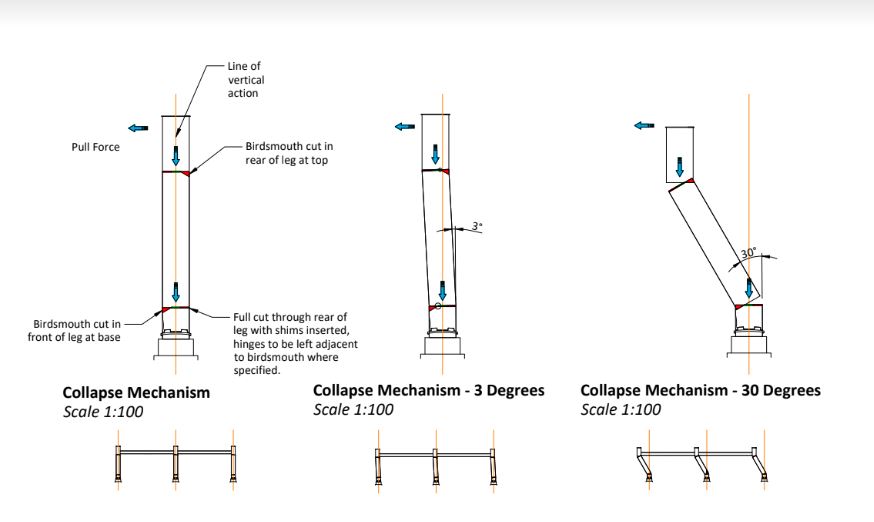The requirement for offshore platform decommissioning and demolition is rising as many ageing platforms in the North Sea approach the end of their operational life.
This is highlighted by the fact that 180, of the 283 currently active oil and gas fields, are due to have ceased production by 2030, with each of these structures needing to be decommissioned and demolished safely and effectively.
Decommissioning Process
The decommissioning of oil and gas platforms can be split into four sections:
- Cease production
- They are decommissioned and decontaminated
- Towed/lifted onshore for demolition
- Pulled/blown down for processing or dismantled piecemeal to be recycled

Drawing of the pull down of an offshore platform using a pull down demolition methodology
Offshore Platform Demolition Challenges
The demolition engineering of offshore platforms can involve a complex combination of technical, environmental, and logistical challenges.
These challenges range from ensuring the structural integrity during the demolition process to preventing environmental contamination and managing the sheer size and weight of the platforms.
Structural Stability
Temporary Works/Demolition Engineers need to evaluate the stability of the topsides or jackets during the dismantling process; reviewing both the global stability of the structure to remain and the local stability of the elements being removed.
If a blow down or pull down is proposed, the pre-weakening of the structure must be considered from a structural standpoint prior to initiating a collapse mechanism.
Environmental Protection
Offshore rigs handle environmentally hazardous materials that need to be contained. Ensuring that hazardous materials are removed before demolition is vital to preventing contamination.
Handling Large Structures
The size and weight of offshore rigs pose significant logistical challenges; from the transport onshore to the determination of the most effective/safe demolition methodology. SPMTs ( self propelled modular transporters) are often used for the transportation of smaller elements, with dry docks being used for larger complete topsides and jackets.
Offshore Platform Demolition Methods
There are two main types of offshore rig demolition methodology – dismantling or a controlled pulldown of the structure.
Dismantling vs. Controlled Pulldown/Blowdown
Choosing between a dismantling or controlled pulldown/blowdown methodology depends on the unique challenges and requirements of each offshore platform demolition project:
Dismantling Offshore Rigs
Dismantling an offshore platform involves using cranes to carefully take apart the platform section by section.
This begins with the use of cranes or other heavy equipment to carefully remove sections of the rig, starting from the top and working downwards in most situations.
By dismantling the platform piece by piece, workers can control the process more effectively.
Controlled Pulldown of Offshore Rigs
A controlled pulldown is a demolition method used to safely bring down offshore rigs by pre-weakening critical parts of the structure and then pulling it down in a controlled manner.
Critical components, such as legs or beams are weakened ready for the initiation of a controlled collapse.

Drawing of a pre-weakening collapse mechanism design
Once the rig is sufficiently weakened, large equipment like winches or heavy-duty excavators are used to apply the necessary pulling force. This force causes the rig to collapse in a controlled direction, ensuring it comes down safely.
The controlled collapse is designed to ensure the structure falls predictably, which allows for safer and more efficient processing once the rig is on the ground.
Explosive Blowdown of offshore rigs
As an alternative to initiating a collapse via pulldown, explosives can be used to complete the final elements of pre-weakening and initiate a collapse.

